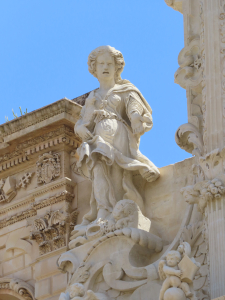
Lecce Baroque styling means artistic flourishes carved in white limestone.
In Part 4, we discovered conical roofs of flat rocks not bound with mortar can be quite useful to thwart a King’s taxman and in today’s market, bring in the big bucks.
what we learned:
Barocco leccese is an ornate artistic style developed in Lecce and in Terra d’Otranto allegedly between the second half of the 16th century and the end of the 17th. It was developed as a thanks to God for protecting Christianity from the Ottomans. Lecce Baroque style leaves no empty spaces. The thinking was that empty space lets in the Devil. The 2,000-year-old city is considered the “Florence of the South” for the breadth of the fanciful designs of human figures, flowers, and animals carved in white limestone materials encouraged by Charles V, King of Spain, instead of the marble used in Naples. In Lecce, elaborate corbels appear under railings. Classical sculptures of women line the sides of doorways. The point of Baroque design is to wow!
Our local guide noted that Lecce Baroque is an attitude that prefers style over substance. Someone who flaunts what they have has a “Lecce Baroque attitude.”
University of Salento students believe a local superstition not to walk under the school’s arch if they haven’t finished exams or they may face difficulty graduating.
The city’s residents even have their own coffee specialty. Café leccese contains espresso, ice cubes, and almond milk.
Siesta hours run from about 1:30 to 4 pm. Some of the smaller artisan shops stay open for tourists.
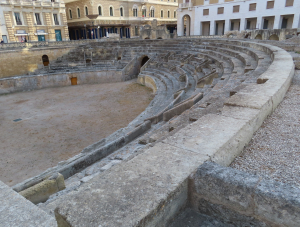
The Roman Amphitheater of Lecce is situated in the main piazza of the old town.
The Roman Amphitheater of Lecce is situated in the main piazza of the old town. It was completely hidden from view and its existence unknown until 1901 when workers building the Bank of Italy unearthed it. The amphitheater is still used as a venue for events and performances.
There are about 100 churches in Lecce for a current population of about 95,000.
where we stayed:
The Mercure Hotel President Lecce is fine as hotels go, but an unexpected disappointment on this trip. Days before departure on our Odysseys Unlimited two-week Sicily-Southern Italy tour we were informed our group’s reservation had switched from the historic Patria Palace Hotel in the heart of Lecce to Mercure Hotel President Lecce. I was reassured by our tour company that the two properties were rated similarly by hotel standards even though Trip Adviser and other sites listed our new hotel as more of a budget-priced hotel. Again, the hotel was vanilla; okay, if generic and more of a business hotel than for leisure travelers who enjoy historical properties. The chief complaint from any of our 18-member group was the distance and disconnect felt to the city’s activity. The morning buffet was plentiful with fruits, breads, cheeses, and desserts. Staff were friendly and helpful.
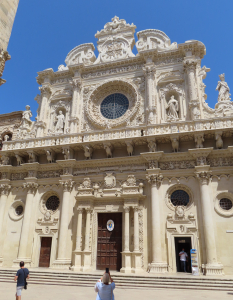
The Cathedral of Duomo is prominent in the city’s center of activity.
what we did:
The Cathedral of Duomo, a prime example of Lecce baroque style, occupies a prominent position in the center of the city in the southeast corner of the Piazza del Duomo. Built in 1144, it underwent repairs in 1230. In 1659 Giuseppe Zimbalo rebuilt it under the auspices of Bishop Luigi Pappacoda, whose remains are entombed in the altar dedicated to Saint Orontius of Lecce, patron saint of the city. Alongside the Duomo is the 17th century Bishop’s Palace and the 18th century Palazzo Seminario. The most impressive building in the piazza though is the 230-foot bell tower, which serves as the marker for where one is in the city.

Paper mâché figurines of Cartapesta Claudio Riso in his Lecce studio.
Paper mâché has been a popular vehicle in Lecce for replicating Lecce Baroque style of flowery ornamentation on buildings, statuary, or creating fanciful décor. We popped into the studio of one of the city’s most renowned paper mâché artists, Cartapesta Claudio Riso. For about 40 years, using only the special Amalfi paper made from lemons, he has crafted intricate figurines and vignettes delicate in the portrayal of character and emotions, but rich in color and texture.
One of the most fun evenings our tour group of 18 shared was dinner and dancing in a palazzo with an impressive royal history. The seventh-generation lady of the house has two sons to continue the family legacy. The palace was originally built by the French Count of Lecce in the 14th century on top of Roman ruins. His daughter Maria inherited the property. Details get a bit sketchy (in my head) about how many marriages and children Maria had, but she did marry the King of Naples. The convoluted family history is irrelevant to the evening except that during the additions and renovations over the ensuring centuries, a second century Roman theater was discovered.
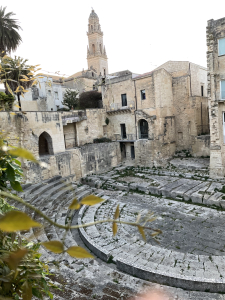
After seven years of excavation, this much of the Roman theater was uncovered in the back yard of the palace in Lecce.
For seven years, excavations continued until the family realized if they kept going, there might not be much left of the palace. On the evening of our visit, we were given time to carefully climb the crumbling steps in the backyard garden to peer over a barrier to the Roman theater site.
Dinner was laid out on long white-lacy cloths for a self-serve buffet in one of many large rooms. There were two types of pizza, salads, spaghetti and meatballs, and breads. Afterwards, a three-piece band appeared to play local folk music, sing, and get us all up to dance. The steps reminded me of a Columbian bachata and were easy enough to follow when they pulled me up. Dave W. was pulled up minutes later for us to dance to a song about a flirtation between a man and a woman. Poor Dave wasn’t quite sure how to “flirt” with anyone other than his wife, Vivian (or at least that’s the story he laughingly announced). Most people rose to dance. What a fun way to finish the evening!
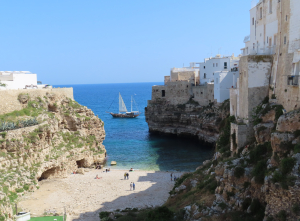
On a clear day in Otranto you might be able to see Albania.
One of our day trips while based in Lecce was a short visit to Otranto, an ancient city along the Adriatic coastline. Our ultimate destination for the day was to L’Astore Masseria Organic Wines in Cutrofiano. I was going to talk about the history of Otranto and its unexpected, successful defeat of Turkish sea attacks by a more powerful force, but when I tried to verify some of the history, I found it jumbled and decided to leave it alone. What I can say is that I was aware of Otranto from a fictionalized (but nonetheless intriguing) TV series about Leonardo da Vinci and how one of his inventions was allegedly the reason the invading Turks were defeated.
Enroute to Otranto we learned that olive trees in Southern Italy had been destroyed by a virus. New strains of olive trees more resistant to the virus are being developed. We learned a snake symbol represents Otranto.
Otranto separates Italy’s boot heel from the Balkan Peninsula. If the day was clear, we could see across to Albania (or so we were told.) So why did I keep hearing Barbra Streisand singing in my head, “On a clear day you can see Albania?”
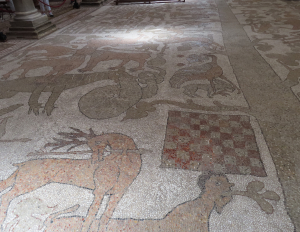
The Tree of Life in this 12-th century mosaic tile floor tells the story of the Old Testament.
We visited the Norman Church built in 1088, Basilica Otranto, dedicated to the Annunciation of the Virgin Mary. The most famous feature of the cathedral is the 12th-century mosaic tile floor that tells the story of the Old Testament, the medieval chivalry literature of heroes and myths, all of which are placed surrounding the Tree of Life. The flooring is one of the best examples of this type of mosaic-tiled storytelling work to survive. Every image has a purpose. The symbols represent good vs evil. In 1693 a Baroque wooden roof was added.
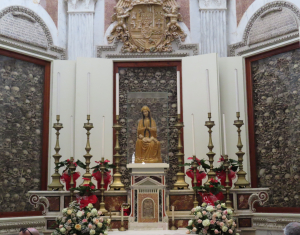
Inside the Chapel of Bones in Basilica Otranto.
The basilica has a chapel of bones allegedly using the bones of 800 men killed in the battle with the Turks in 1480. (Was this the battle I’d seen portrayed on the TV show?) The Turks had allegedly taken over the cathedral and turned it into a mosque. Once defeated by Alfonso V of Aragon in 1481, he took the bones to Naples and returned the converted mosque back into a church. Russ and I have seen a more elaborate, entire Chapel of Bones in Portugal.*
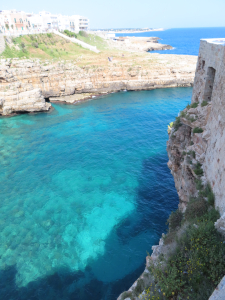
Shades of blue against the white stone of the fortified castle.
Otranto is known as the “city of balconies” for all the houses, hotels, restaurants, and businesses that have white terraces or balconies overlooking the painting-perfect blue water. Other than the church and quick glances at souvenir, shoe or clothing shops crowded into just a few streets, the attraction of is the ombre water of bluest shades against the reflective white of the buildings abutting the shoreline, creating a poet’s serene muse. Intimate-sized cafes compete for space with scenic views and ice cold limoncello spritzers. It was at one of these small cafes on the edge of a terrace with wonderful views of the water that a frosty limoncello spritzer capped off perfection.
where we ate:
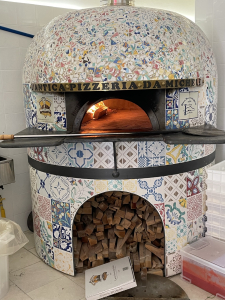
This mosaic-tiled pizza oven at Da Michele Lecce in Lecce.
You’d think our effusive Odysseys Unlimited Tour Director (stage theater performer) Andrea F. had just won the Best Actor award for his level of excitement at spotting pizza restaurant, Da Michele Lecce, had opened. L’Antica Pizzeria Da Michele had originated in Naples (Andrea’s hometown) in 1870, and is his favorite go-to place when home. We followed the advice of others in our group who arrived before us that one pizza split two ways was plenty for lunch. Even so, we barely finished the light cheese and pork sausage thin-crust pizza. There were two other details that made this new two-story franchised pizza restaurant memorable. On your immediate left upon entering was a gorgeous, ornate mosaic-tiled pizza oven in flowery primary colors. The other would be at least half-a-dozen framed pictures of Actress Julia Roberts contentedly chowing down on a piece of L’Antica Pizzeria Da Michele pizza during the filming of her 2010 movie, Eat, Pray, Love.
Another one of the many reasons Russ and I adore travelling with Odysseys Unlimited is the special arranged events such as cooking classes and wine/olive oil tasting where the produce is grown. Typically, the farm or vineyards are family owned and there always seems to be an interesting backstory. L’Astore Masseria Organic Wines in Cutrofiano fit that bill to a T.
First, we dined in the house this family has owned since 1935 on food grown on their farm. We drank from their wine collection. Each wine is made from only one grape of the five they use, but all are certified organic. We feasted on fresh-baked bread, black olives, and ripe tomatoes, along with crunchy garden salad with cucumbers, tomatoes, potatoes, and carrots.
While we ate, we sampled wines. The first was a 2020 rose’ of white peach, almond and white musk made from a Malvasia Bianco grape. This grape is grown widely throughout the world in places like Italy, the San Joaquin Valley (CA), and the Greek islands of Paros and Syros.
The second course was risotto with shredded zucchini, onion, and black pepper. There was cauliflower sprinkled with olive oil and chicken pieces dressed out in rosemary, oregano, and olive oil. Served with this course was Massaro Rosa wine made from the negroamaro grape. a dark-skinned grape variety linked to the Puglia region for at least 1,500 years. This wine is typical of the area with strong notes of strawberry and cherry.
Dessert was homemade strawberry sorbet. The wine that accompanied it was a red that utilized the same grape as the rose’ we first had.
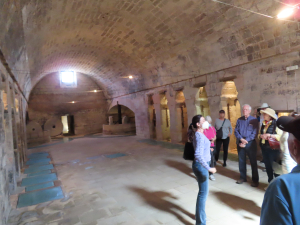
The old mill is used as event space.
Before this scrumptious meal and wine could render us asleep on our feet for a well-earned nap, we were rousted for an adventure into the history of this fascinating farm and the underground mill that made it famous. In 1935, this multigenerational family’s ancestors bought the house and farm from the estate of Professor Achille Benegiamo, who ran an underground mill there from the 1700’s. The mill, one of the largest in Salento, produced oil until 1916. It was then converted into a wine cellar. We stepped down into this cavernous space (you could feel a damp chill almost immediately once below) that is now used only for special events.
The family’s guide showed us a bare side room with large square openings along the wall. She said when the oil mill was in production, the workers never left the farm. They slept all together in one room with the animals. Urine was saved to tan the leather. The square openings were where the olives were stored. The olive oil was used for lamp oil and for food. Between WWI and WWII, an industrial revolution occurred. Lamp oil was no longer necessary. The business finally folded in 1935.
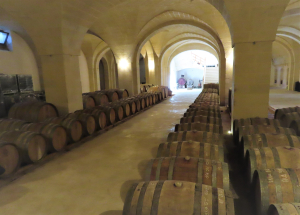
The wine cave of L’Astore Masseria Organic Wines.
Today, the winery produces 60,000 bottles of wine a year and two tons of olive oil. They are a small company that prefers quality over quantity. The wine is stored in French oak barrels for months and used three times before the barrels are sold to whiskey producers in the United States. They do use an acacia wood barrel for their top wines made from the oldest grapes. L’Astore Masseria Organic Wines spend 20 months in barrels and then one year bottled. Following our tour, we were given tastings of other wines they sell. I don’t recall anyone leaving without buying at least one bottle of a favorite.
*SPAIN AND PORTUGAL: HOW CENTURIES OF RELIGIOUS BATTLES LED TO ARCHITECTURAL WONDERS, SAVVY CUISINE, FRAGRANT WINES, AND THE HEROICS OF WHICH NOVELS ARE WRITTEN. (https://karenkuzsel.com/2017/06/21/spain-and-portugal-how-centuries-of-religious-battles-led-to-architectural-wonders-savvy-cuisine-fragrant-wines-and-the-heroics-of-which-novels-are-written/)
In Part 6, we leave Puglia behind and enter Campania, a district that includes Pompeii, the Amalfi coast, the resort Isle of Capri, and the charming Sorrento.
https://odysseys-unlimited.com
https://www.lastoremasseria.it/
Karen Kuzsel is a writer-editor based in the Orlando area who specializes in the hospitality, entertainment, meetings & events industries. She is an active member of International Live Events Association and Meeting Professionals International and is now serving on the 2021-2022 MPI Global Advisory Board for Small Business Owners. She is a member of the Society of Professional Journalists. Karen writes about food & wine, spas, destinations, venues, meetings & events. A career journalist, she has owned magazines, written for newspapers, trade publications, radio and TV. As her alter-ego, Natasha, The Psychic Lady, she is a featured entertainer for corporate and social events. Karen@KarenKuzsel.com; www.KarenKuzsel.com; www.ThePsychicLady.com; @karenkuzsel; @thepsychiclady. Food photos for this series by Karen Kuzsel. All other Photos by Russ Wagner, a retired government planner/builder who has a passion for historic architecture, wine, trains, travel and taking photographs.
